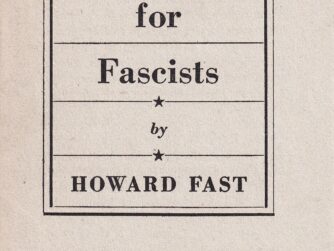Cold War Radio Museum Books in Paperback and Kindle
The “Divide and Conquer” pamphlet published by the U.S. Office of War Information (O.W.I.) in 1942 is a unique example of government attempts to warn Americans during World War II about the dangers of Nazi propaganda and to help them identify and guard against enemy disinformation. The instructional brochure, transcribed and republished by the Cold War Radio Museum for the first time in several decades with an extensive introduction by international journalist, broadcaster, writer and propaganda expert Ted Lipien, also offers interesting lessons for today’s propaganda wars with their clandestine and overt operations undertaken by authoritarian governments of countries such as Russia and China to influence and subvert U.S. political and electoral system.
“He knows that prejudice in any form plays his game,” the wartime guide to Nazi propaganda warned Americans about Hitler’s motives.
“Before Hitler attacks any country, his agents carefully sow seeds of hate and disunity, turning people against their own governments, governments against their allies, class against class.”
It could have been easily a comment on the current aims of the Kremlin’s propaganda or the behavior of some politicians, both foreign and domestic, who engage in fear mongering and subversion of democratic elections. Ted Lipien shows how this expose of Nazi propaganda is still highly relevant for today’s information wars.
In 1942 Americans received the warning that Hitler wanted “To destroy our national unity [and] create unrest in all groups of the population.”
The alert was undoubtedly timely and based on solid evidence although it was less obvious that such Nazi subversion was producing the desired effect of changing American minds as it did when used against some of the European nations. In America, Hitler’s propaganda was said to be “trying to set capital against labor, White against Negro, Catholic against Protestant, Christian against Jew.”
The warnings about Hitler’s intentions were true, but there was little evidence presented in the U.S. government pamphlet mailed out to American households that Nazi propaganda was achieving its ends among Americans. Similarities with some of today’s propaganda, however, are immediately apparent in the 1942 brochure and make for a very interesting and enlightening reading of this historical document reprinted for the first time in many years.
In the first months of the war with Japan and Nazi Germany, the Roosevelt Administration became concerned about Japanese and German propaganda attempting to to influence American public opinion. In articles reminiscent of some of the media reporting on Russian interference in the 2016 presidential election campaign, Americans were told that German and Japanese propaganda radio broadcasts were interfering with the U.S. electoral process.
Even though the “Divide and Conquer” pamphlet was strictly about resisting the influence of Nazi ideology, it still offers valuable lessons for identifying attempts at interference from any ideological perspective and any government or media source. This includes the Russian State now headed by an ex-KGB officer President Vladimir Putin. He has shown himself to be an expert in the use of propaganda, disinformation and subversion. Many of the Nazi propaganda techniques described in this booklet have not changed and are now being used with the help of new digital technologies against the United States and other democratic nations. Ultimately, there was not much difference between the evils of Fascism and Communism and their respective propaganda. While “Divide and Conquer” presented and warned against only one type of propaganda, we can still draw today many valuable lessons from this 1942 U.S. government document.









